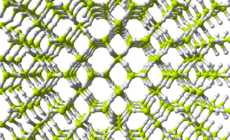Heptene
Heptene is a higher olefin, or alkene with the formula C7H14. The commercial product is a liquid that is a mixture of isomers. It is used as an additive in lubricants, as a catalyst, and as a surfactant. This chemical is also known as heptylene.

| Names | |
|---|---|
| IUPAC name
hept-1-ene | |
| Identifiers | |
3D model (JSmol) |
|
| ChemSpider | |
| ECHA InfoCard | 100.008.881 |
PubChem CID |
|
| UNII | |
CompTox Dashboard (EPA) |
|
| |
| |
| Properties[1] | |
| C7H14 | |
| Molar mass | 98.189 g·mol−1 |
| Appearance | Colorless liquid |
| Density | 0.697 g/mL |
| Melting point | −119 °C (−182 °F; 154 K) |
| Boiling point | 94 °C (201 °F; 367 K) |
| Hazards[1] | |
| R-phrases (outdated) | R11 R36/37/38 R65 |
| S-phrases (outdated) | S16 S26 S36 S62 |
| Flash point | −9 °C (16 °F; 264 K) |
Except where otherwise noted, data are given for materials in their standard state (at 25 °C [77 °F], 100 kPa). | |
| Infobox references | |
Chemical reactions
- Free-radical reactions
- Oxidation reactions
- Dehydrocyclization reactions
Uses and Manufactures
- Einstein Theory
- Ziegler Process
- Second-order Elimination reactions
- intermediate material for organic synthesis
Spectroscopy
- UV Spectroscopy
- IR Spectroscopy
References
2. Carl Schaschke, 2014, A Dictionary of Chemical Engineering, Oxford University Press.
3. G. I. Nikishin, Yu. N. Ogibin & L. Kh. Rakhmatullina, 1975, ‘Peroxydisulfate-initiated reactions of 1-heptene with acetic and propionic acids’, Bulletin of the Academy of Sciences of the USSR, Division of chemical science, volume 23, pages1479–1483
4. Yu. D. Shenin, T. V. Kotenko & A. N. Egorenkova, Nystatin. IV. 1969, The heptaene component of samples of nystatin-nursimicin, Pharmaceutical Chemistry Journal volume 3, pages 631–634
5. Nicholas E. Leadbeater, Cynthia B. McGowan, 2013, Experiment 2: Second-Order Elimination Reaction Preparation of Heptene from 2-Bromoheptane, Laboratory Experiments Using Microwave Heating, chapter 3
6. E. S. Mortikov, M. I. Rozengart & B. A. Kazanskii, 1968, Dehydrocyclization of n-heptenes under conditions of a pulsed system and in the usual flow-type setup, Bulletin of the Academy of Sciences of the USSR, Division of chemical science volume 17, pages95–98(1968)






